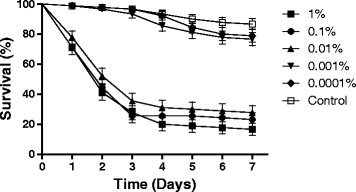Neem oil increases the efficiency of the entomopathogenic fungus Metarhizium anisopliae for the control of Aedes aegypti (Diptera: Culicidae) larvae
- PMID: 26715150
- PMCID: PMC4696216
- DOI: 10.1186/s13071-015-1280-9
Neem oil increases the efficiency of the entomopathogenic fungus Metarhizium anisopliae for the control of Aedes aegypti (Diptera: Culicidae) larvae
Abstract
Background: Entomopathogenic fungi are potential candidates for use in integrated vector management and many isolates are compatible with synthetic and natural insecticides. Neem oil was tested separately and in combination with the entomopathogenic fungus Metarhizium anisopliae against larvae of the dengue vector Aedes aegypti. Our aim was to increase the effectiveness of the fungus for the control of larval mosquito populations.
Methods: Commercially available neem oil was used at concentrations ranging from 0.0001 to 1%. Larval survival rates were monitored over a 7 day period following exposure to neem. The virulence of the fungus M. anisopliae was confirmed using five conidial concentrations (1 × 10(5) to 1 × 10(9) conidia mL(-1)) and survival monitored over 7 days. Two concentrations of fungal conidia were then tested together with neem (0.001%). Survival curve comparisons were carried out using the Log-rank test and end-point survival rates were compared using one-way ANOVA.
Results: 1% neem was toxic to A. aegypti larvae reducing survival to 18% with S50 of 2 days. Neem had no effect on conidial germination or fungal vegetative growth in vitro. Larval survival rates were reduced to 24% (S50 = 3 days) when using 1 × 10(9) conidia mL(-1). Using 1 × 10(8) conidia mL(-1), 30% survival (S50 = 3 days) was observed. We tested a "sub-lethal" neem concentration (0.001%) together with these concentrations of conidia. For combinations of neem + fungus, the survival rates were significantly lower than the survival rates seen for fungus alone or for neem alone. Using a combination of 1 × 10(7) conidia mL(-1) + neem (0.001%), the survival rates were 36%, whereas exposure to the fungus alone resulted in 74% survival and exposure to neem alone resulted in 78% survival. When using 1 × 10(8) conidia mL(-1), the survival curves were modified, with a combination of the fungus + neem resulting in 12% survival, whilst the fungus alone at this concentration also significantly reduced survival rates (28%).
Conclusions: The use of adjuvants is an important strategy for maintaining/increasing fungal virulence and/or shelf-life. The addition of neem to conidial suspensions improved virulence, significantly reducing larval survival times and percentages.
Figures



Similar articles
-
Neem oil increases the persistence of the entomopathogenic fungus Metarhizium anisopliae for the control of Aedes aegypti (Diptera: Culicidae) larvae.Parasit Vectors. 2019 Apr 11;12(1):163. doi: 10.1186/s13071-019-3415-x. Parasit Vectors. 2019. PMID: 30975207 Free PMC article.
-
The combination of the entomopathogenic fungus Metarhizium anisopliae with the insecticide Imidacloprid increases virulence against the dengue vector Aedes aegypti (Diptera: Culicidae).Parasit Vectors. 2011 Jan 25;4:8. doi: 10.1186/1756-3305-4-8. Parasit Vectors. 2011. PMID: 21266078 Free PMC article.
-
Activity of additives and their effect in formulations of Metarhizium anisopliae s.l. IP 46 against Aedes aegypti adults and on post mortem conidiogenesis.Acta Trop. 2019 May;193:192-198. doi: 10.1016/j.actatropica.2019.03.002. Epub 2019 Mar 2. Acta Trop. 2019. PMID: 30836061
-
Old ingredients for a new recipe? Neem cake, a low-cost botanical by-product in the fight against mosquito-borne diseases.Parasitol Res. 2015 Feb;114(2):391-7. doi: 10.1007/s00436-014-4286-x. Epub 2015 Jan 7. Parasitol Res. 2015. PMID: 25563612 Review.
-
Neem (Azadirachta indica): towards the ideal insecticide?Nat Prod Res. 2017 Feb;31(4):369-386. doi: 10.1080/14786419.2016.1214834. Epub 2016 Aug 12. Nat Prod Res. 2017. PMID: 27687478 Review.
Cited by
-
Hydroxyethyl cellulose-based hydrogel as a novel delivery system for Eucalyptus globulus essential oil and Beauveria Bassiana conidia for the control of the poultry red mite Dermanyssus gallinae.BMC Vet Res. 2025 Jul 17;21(1):473. doi: 10.1186/s12917-025-04923-5. BMC Vet Res. 2025. PMID: 40676610 Free PMC article.
-
In Vitro Assessment of Metarhizium Anisopliae Pathogenicity Against Aedes Aegypti Life Stages.Neotrop Entomol. 2024 Dec;53(6):1260-1270. doi: 10.1007/s13744-024-01209-7. Epub 2024 Oct 9. Neotrop Entomol. 2024. PMID: 39382741
-
The Potential of Metarhizium anisopliae Blastospores to Control Aedes aegypti Larvae in the Field.J Fungi (Basel). 2023 Jul 18;9(7):759. doi: 10.3390/jof9070759. J Fungi (Basel). 2023. PMID: 37504747 Free PMC article.
-
Isolation and identification of Xenorhabdus and Photorhabdus bacteria associated with entomopathogenic nematodes and their larvicidal activity against Aedes aegypti.Parasit Vectors. 2017 Sep 21;10(1):440. doi: 10.1186/s13071-017-2383-2. Parasit Vectors. 2017. PMID: 28934970 Free PMC article.
-
A Novel Model of Pathogenesis of Metarhizium anisopliae Propagules through the Midguts of Aedes aegypti Larvae.Insects. 2023 Mar 28;14(4):328. doi: 10.3390/insects14040328. Insects. 2023. PMID: 37103143 Free PMC article.
References
-
- Dengue and severe dengue: World Health Organization; 2014:117. http://www.who.int/mediacentre/factsheets/fs117/en/.. Accessed date: 4th Apr 2015.
-
- Ministro da saúde debate situação da dengue em São Paulo. http://portalsaude.saude.gov.br/index.php/cidadao/principal/agencia-saud.... Accessed 4 Apr 2015.
-
- Montella IR, Martins AJ, Viana-Medeiros PF, Lima JB, Braga IA, Valle D. Insecticide resistance mechanisms of Brazilian Aedes aegypti populations from 2001 to 2004. Am J Trop Med Hyg. 2001;2007(77):467–477. - PubMed
-
- da-Cunha MP, Lima JB, Brogdon WG, Moya GE, Valle D. Monitoring of resistance to the pyrethroid cypermethrin in Brazilian Aedes aegypti (Diptera: Culicidae) populations collected between 2001 and 2003. Mem Inst Oswaldo Cruz. 2001;2005(100):441–444. - PubMed
Publication types
MeSH terms
Substances
LinkOut - more resources
Full Text Sources
Other Literature Sources

